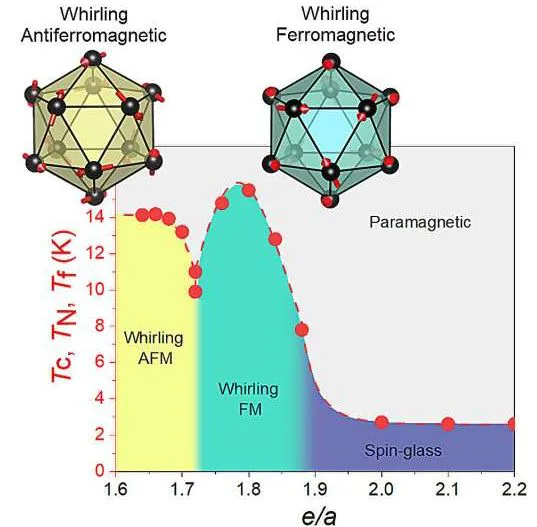
Quasicrystals are interesting materials since they defy regular atomic pattern. It’s non-repeating structure captivates researchers. Since, it leads to extraordinary properties. Thus, the exotic traits not only challenge the traditional material science views but the same also inspire countless innovations.
However, there is a rebel in the family of quasicrystals, the Tsai-type icosahedral quasicrystal (iQC). It is a specific variant of quasicrystal with a unique atomic arrangement characterized by icosahedral symmetry. The symmetry involves a structure that resembles a 20-sided polyhedron.
Tsai-type Quasicrystals
Not only this, the Tsai-type icosahedral quasicrystal and its cubic approximant crystals exhibit unique magnetic characteristics (ferromagnetic and anti-ferromagnetic ordering). And display unconventional behavior at the quantum level (quantum critical phenomena).
Ferromagnetic ordering involves parallel alignment of magnetic moments, creating a strong overall magnetization. While anti-ferromagnetic ordering involves alternating opposite alignments, resulting in a weaker net magnetization. These magnetic orderings are vital for understanding material behavior in magnetic fields, with applications in magnetic storage devices and spintronics.
On the other hand, quantum critical phenomena refer to abrupt changes in the physical properties of a material as it undergoes a quantum phase transition. During a quantum phase transition, the system undergoes a qualitative transformation, leading to the emergence of new phases of matter.
Coming back to the Tsai-type icosahedral quasicrystal, with precise compositional adjustments, these materials can showcase intriguing features like aging, memory, and rejuvenation. This versatility gives them the spotlight for next-gen magnetic storage devices. But as of now, there is limited knowledge about how these materials behave in different magnetic conditions.

Researchers Explores Mysteries of Tsai-type Quasicrystals
To delve deeper into the mysteries, a team of researchers, headed by Professor Ryuji Tamura from the Department of Materials Science and Technology at Tokyo University of Science (TUS), joined forces with researchers from Tohoku University.
Their focus was on conducting magnetization and powder neutron diffraction (PND) experiments. What set the stage for investigation was the non-Heisenberg Tsai-type 1/1 gold-gallium-terbium approximant crystal.
Phase Diagrams for Non-Heisenberg Tsai-type Crystals
Breaking new ground, the researchers successfully unraveled the phase diagrams of the non-Heisenberg Tsai-type approximant crystals (AC). “Phase diagrams” are visual tools that depict the various states a material can undergo. The effect shows how it changes under different conditions like temperature and pressure.
This groundbreaking achievement is poised to significantly enhance applied physics research, particularly in the realms of magnetic refrigeration and spintronics.
After conducting a series of experiments, the researchers successfully crafted the inaugural comprehensive magnetic phase diagram for the non-Heisenberg Tsai-type approximant crystal (AC).
The diagram covers various electron-per-atom (e/a) ratios, crucial for understanding quasicrystals (QCs). Using powder neutron diffraction (PND), measurements revealed a noncoplanar whirling anti-ferromagnetic (AFM) order at an e/a ratio of 1.72 and a noncoplanar whirling ferromagnetic (FM) order at the e/a ratio of 1.80.
Additionally, the team clarified the rules governing the selection of ferromagnetic and anti-ferromagnetic phases in magnetic interactions. They achieved this by closely examining how magnetic moments align between nearest-neighbor and next-nearest-neighbor sites.
A Bright Future in Condensed Matter Physics
Professor Tamura emphasizes that their discoveries pave the way for the future of condensed matter physics.
He further added that the findings provide crucial insights into magnetic interactions in non-Heisenberg Tsai-type approximant crystals (ACs). They establish a foundation for understanding the intriguing properties of both non-Heisenberg Acs. And yet-to-be-discovered non-Heisenberg icosahedral quasicrystals (iQCs).

Takeaway
As mentioned before, the discoveries on non-Heisenberg Tsai-type approximant crystals (ACs) and the insights into their magnetic interactions will likely have a significant impact on the future of condensed matter physics.
These discoveries could lead us to new frontiers, especially when it comes to uncovering yet-to-be-discovered non-Heisenberg icosahedral quasicrystals (iQCs).
This expanding knowledge could shake things up, influencing everything from magnetic tech to different parts of condensed matter physics. Get ready for a burst of innovation in materials science!



